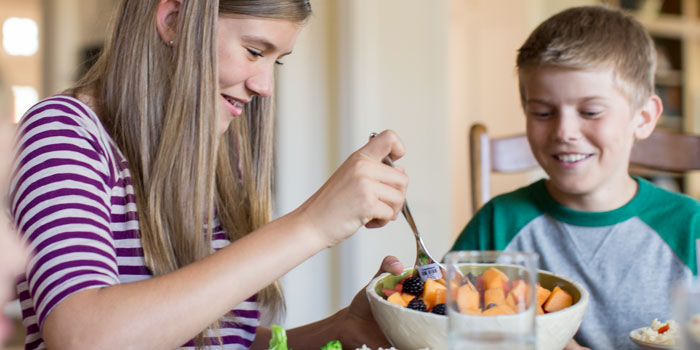Starting on solid foods
Fruits and vegetables are an important part of your child’s eating plan. Your goal is five servings per day for younger children and five to nine servings per day for teens and parents. Every meal and snack should include at least one serving of a fruit or vegetable.

The American Academy of Pediatrics says you shouldn’t give infants solid foods before four to six months of age. Here are some signs that your infant may be ready to start eating solid foods:
- They can sit up on their own in a high chair.
- They can move their head and neck well.
- They show interest in eating what you’re eating.
How to begin
- Start with one-ingredient foods. Try each kind of food, one at a time, every few days. This will help your infant to get used to the taste and texture of each new food. It’ll also help you see if your child has a bad response. That could be a sign of a food allergy or sensitivity.
- Stay away from foods with added sugar and salt. There’s no need to buy baby foods from the store. Putting your own foods in a blender is great. Just be sure to check for hidden chunks that may be a choking danger.
- It takes 10 to 20 tries of a new food for a baby to decide likes or dislikes. The first time you try peas, your baby may make a face or spit it out. If he or she still spits it out, try a different food. And keep offering peas in future meals.
- Offer a variety of vegetables before you offer sweeter fruits. This helps infants get to like a wide range of flavors.
- Offer servings that are the right size for your infant. (See the “Serving sizes” article.)
- Use the “Hunger signs” handout on our website to help you know when your child is hungry and full.
- Don’t eat off the same spoon as your infant. Adult mouths have germs. You don’t want to pass these germs to your infant’s mouth.
- By eight to 10 months, infants may be able to feed themselves. They can sit up on their own. They can pick up and drop food. They can chew or gum food and swallow.
Be careful about choking
Food pieces that are too big can cause choking. Foods should be soft and easy to chew and swallow. Don’t cut finger foods into coin shapes. Foods that have a high danger for choking include grapes, nuts, carrot rings, hot dog slices, popcorn and large beans. Stage three foods are blended foods that have chunks. If your child has difficulty with stage three foods, just skip this stage and offer normal table foods. Stage 3 is a complex mix that may confuse infants when a hidden chunk suddenly appears.
Foods to wait on
Don’t give cow’s milk, or hard, round foods that could cause choking, to children in the first year. Don’t give honey to children under two. There’s a chance they could get botulism food poisoning.
Not sure if your child is ready?
If you’re not sure if your child can handle a certain food, try using a mesh feeder.
This type of baby feeder has a small mesh bag attached to a handle. You put food into the bag and the baby sucks the food out. The mesh stops large chunks of food or seeds from getting into your baby’s mouth. Infants can suck and gum the feeder to get food and flavor safely.
